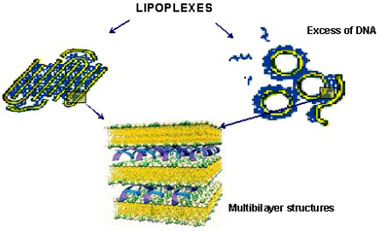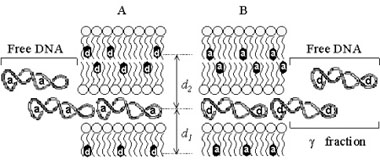 
Lipid/DNA complexes
Gene therapy offers promise for the treatment
of disease through the use of DNA based vectors that allow targeting,
delivery of DNA to cells and expression of the gene. Among the
non-viral vectors, cationic liposomes seem to be the most widely used
DNA delivery system. Despite low transfection efficiencies, they show
nonimmunogenicity, low toxicity and possibility of large scale
production. Many efforts have been made to fully characterize cationic
liposome-DNA complexes (lipoplexes), because it is the only way to
understand, improve and control the transfection efficiency of these
non-viral based vectors.
In 1987, it was reported for the first time
that plasmid DNA and cationic liposomes aggregate due to electrostatic
attractive forces and origin small complexes able to transfer DNA to
the cells. In the late 90's, electron microscopy and X-ray diffraction
used in parallel revealed a multilamellar structure of lipid bilayers
with sandwiched DNA, with a constant interlayer spacing invariant with
the charge ratio, and depending on cationic liposomes formulations
(Figure 1).

|
|
Figure 1 - Cartoon showing the
multilamellar organization of lipoplexes
|
In our lab, we developed FRET models assuming
a multilamellar lipoplex arrangement (Figure 2). The application of
these models allows the determination of the distance between the
fluorescent intercalator on the DNA and a membrane dye on the lipid,
and/or the evaluation of encapsulation efficiencies of this liposomal
vehicle.

|
|
Figure 2 - Schematic representation of
the FRET experiments designed to obtain the lamellar spacing (d
≈ d1 ≈ d2 in the figure) and
free DNA fraction (γ in the picture) of lipoplexes. Two arrangements
were used, donor (d) in the lipid acyl chains and acceptors (a)
intercalated in the DNA (A) or the other way round (B).
|
go back to Research Interests
|